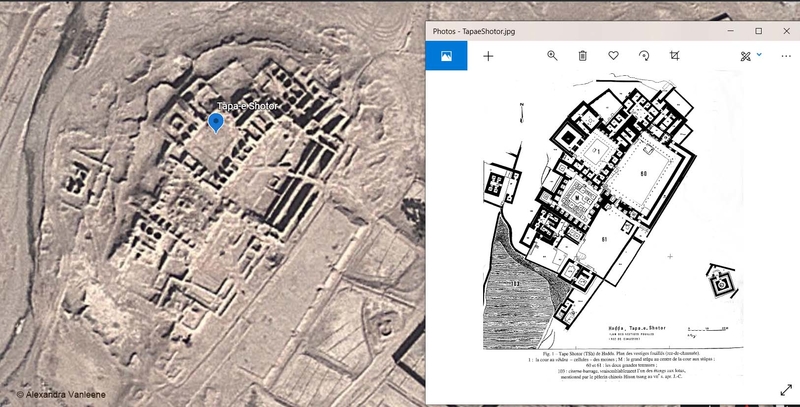Tapa-e Shotor
The excavation of the Tapa-e Shotor site (abbreviation: TSh), "The Camel Hill", was started by Shaïbaï Mostamindi Mostamindi and continued by Zemaryalaï Tarzi.
Tapa-e Shotor marked the northern limit of the Haḍḍa monastic complex. Stratigraphic data and the study of numismatics have allowed Tarzi to establish nine phases: TSh I corresponds to the beginning of the premonastic settlements and is dated from Azes II (35-12 BCE). TSh II, the first Buddhist period is contemporary with the reign of Huviṣka in the second half of the 2nd century CE (155-187). TSh III falls between the end of Huviṣka's reign and the beginning of Vasudeva I's. TSh IV corresponds to the reign of Vasudeva (191-225). An initial hiatus occurs between Vasudeva and his successors. TSh V extends from the post-Vasudeva period to the last Kušan, until about the middle of the 4th century CE. TSh VI corresponds to Kidara's rise to power and extends from the mid-4th to the 5th century. TSh VII is in the 5th, TSh VIII (corresponding to TTK I) in the late 5th and 6th. This is followed by a second and very long hiatus of two and a half centuries, from the beginning of the 6th to the middle of the 8th century CE. Finally TSh IX (corresponding to TTK II) extends from the middle of the 8th to the 9th century when the final fire that ruined the sites took place.
During the TSh II period Vihāra 1 and Niches V1 (representing the Exhortation to Preach), V2 and V3 (both dedicated to the First Sermon) were built, as well as the Stūpas courtyard and niches IV to X and XIV to XVI surrounding it. Niche VI represented the First Sermon, Niche XVI the Visit of Indra to the Indraśala Cave and Niches IX and XIV the Buddhist Heavens. The second Buddhist phase TSh III corresponds to the building of the Great Stūpa M (decorated with a Visit of Indra) and the secondary stūpas 10 and 11 as well as the enlargement of Terrace 60. TSh IV saw the construction of the Meeting Hall 10, the Refectory 13, the forecourt 14 and the courtyard 42. Around Terrace 60, a tower was transformed into Caitya EXXIV (containing stūpa 39), fully decorated to the glory of the Buddhas of the past and with a niche, EXXIVb, depicting the Miracle of Śravasti. Also at this period, Vihāra 43 was built, Terasse 61 was laid out, as well as Chapel 59 containing stūpa 40 and some secondary stūpas around the Stūpas courtyard. Of note are stūpa 6, bearing a representation of the First Sermon, stūpa 20 whose second body was decorated with the Offering of a Handful of Dust and the Jātaka of the Submissive Lion, and stūpa 25 where a scene of the Offering of a Handful of Dust was depicted. In the TSh V period, Vihāra 1 was enlarged with rooms 16 to 18, Terrace 60 was enriched with niches EV, E XI to EXXIII, the Stūpas courtyard saw the construction of Niches I to III, the Vestibule XI and the Chapel XII representing the Buddhist Heavens, the Niche XIII called "aquatic" and the Niches XVII, XIX to XXIV as well as the reorganisation of several stūpas (2, 3, 4, 7, 8, 13, 18, 19, 27). During TSh VI, Vihāra 1 was further redeveloped and enlarged by the construction of rooms 52 to 56 and forecourt 99; around Terrace 60, Niches EVI and EVII as well as Caitya EVIII were built. The Stūpas courtyard was given stūpas 17 and 26, dedicated to the mokṣa ceremony, and the painted decoration of cave A depicting the Ten Monks Protectors of the Law and the Bowl and Turban Cult was completed. During the sixth Buddhist period TSh VII, refurbishments were made in Vihāra 1, stūpas 1 and 20 were added to the Stūpas courtyard, Terrace 60 was enlarged and Niches EIX and EX were added. Finally, the reservoir 103, its dam 104 and the thermal complex 70 to 73 were built. The last periods TSh VIII and IX are equivalent to TTK I and II. In TSh, only repairs took place (Tarzi, 1976: 382 ff. and Tarzi, 1991).
Perspective of the plan of Tapa-e Shotor drawn by Prof. Z. Tarzi (Tarzi, 1997) and of the present state of the site according to Google Earth satellite imagery.

